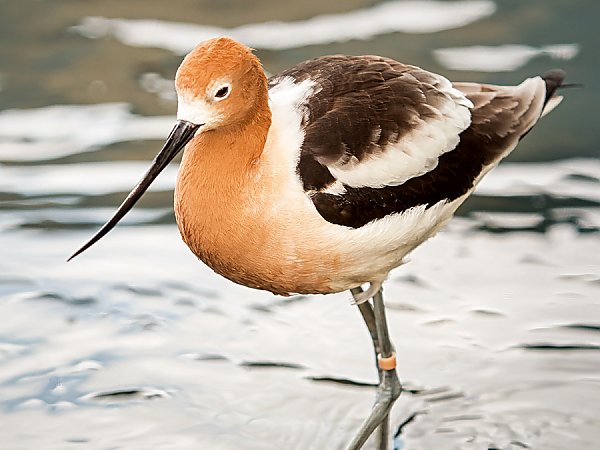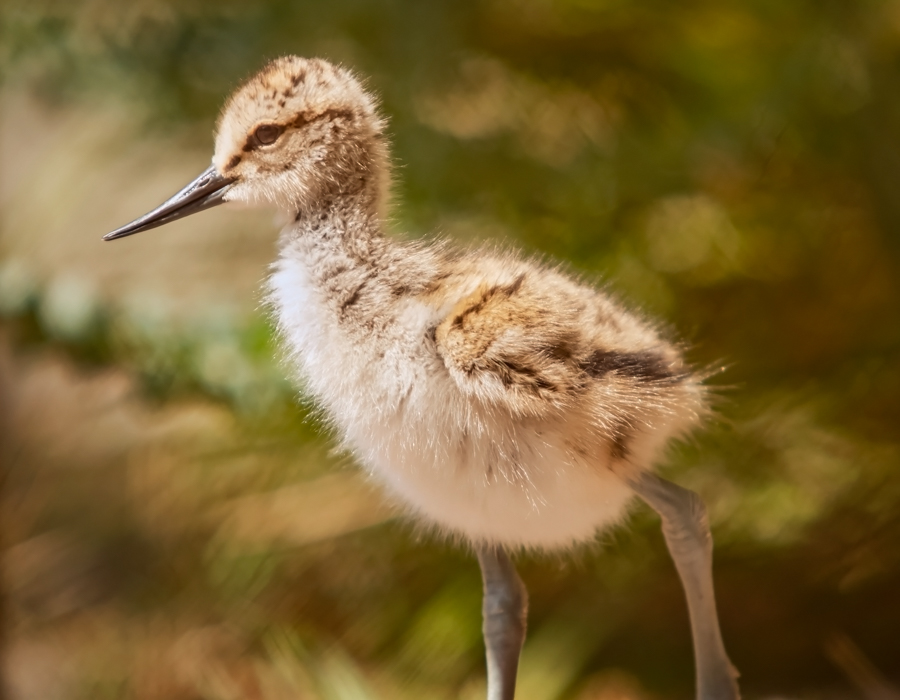American Avocet
Recurvirostra americana
American avocets are elegant, fairly large shorebirds typically found in and around mudflats and wetlands in large flocks. They have a distinctive long, thin bill that curves upward and long legs. They have a white body with black and white stripes on their wings. The head and neck are pinkish-tan or grayish-white, depending on the time of year. Legs and feet are bluish-gray, and the bill is black. This species is protected by the United States Migratory Bird Act.


SPECIES IN DETAIL
American Avocet
Recurvirostra americana
CONSERVATION STATUS:
CLIMATE CHANGE:
At the Aquarium
The Aquarium’s American avocets are on view in the Shorebird Sanctuary exhibit. During breeding season, they may be moved to the Guam Kingfisher aviary.
Geographic Distribution
The American avocet is a migratory bird found in western North America from March through October and coastal California, southern Texas, Louisiana, Florida, south to Guatemala in the winter.
Habitat
American avocets inhabit mudflats, freshwater and saltwater marshes, saline lakes, ponds, wetland, swamps, and coastal bays.
Physical Characteristics
American avocets are elegant, fairly large shorebirds typically found in and around mudflats and wetlands in large flocks. They have a distinctive long, thin bill that curves upward and long legs. They have a white body with black and white stripes on their wings. The head and neck are pinkish-tan or grayish-white, depending on the time of year. Legs and feet are bluish-gray, and the bill is black. The female’s bill curves up slightly more than the male’s.
Size
The American avocet is approximately 16.4 to 20.4 inches (41 to 51 centimeters) in length from bill to tail.
Diet
An omnivore, the American avocet feeds by sweeping their beaks side to side underwater to stir up small fish, aquatic insects, small fish, seeds, and crustaceans. They typically feed in flocks, and occasionally will feed in deeper water using the “tip up” method.
Reproduction
Avocets reach sexual maturity in approximately one year. Breeding takes place between April and June. Avocets are monogamous and somewhat colonial. Mated pairs perform elaborate courtship displays involving bowing and crouching in and out of the water, dancing with wings outspread, and swaying from side to side. Nests are built on the ground and are typically just depressions in the sand, occasionally lined with bits of mud or dry grass. Females will lay three to five olive-colored eggs with black and brown spots. Incubation takes twenty-two to twenty-nine days, with both parents incubating the eggs. The eggs hatch at the same time, and the chicks leave the nest within a day of hatching. Both parents care for the hatchlings until they fledge. Fledging takes place after twenty-five to twenty-eight days.
Behavior
American avocets are migratory birds that form social groups and are colonial nesters. Their calls include a loud “pleeet” or “wheet” and shrill “kleeap” sounds that are often repeated. They become very noisy and aggressive if an intruder approaches their nest.
Adaptation
Their beaks are highly adapted for feeding in mud flats and shallow waters.
Longevity
American avocets tagged with identification bands have been found to live up to nine years in the wild.
Conservation
This species is not listed by the International Union for Conservation of Nature. These birds are affected by the destruction, degradation, and loss of their habitat and pollution.
American avocets are currently protected by the United States Migratory Bird Act and are making a comeback after being over-hunted in the nineteenth and twentieth centuries.
SPECIES IN DETAIL | Print full entry
American Avocet
Recurvirostra americana
CONSERVATION STATUS:
CLIMATE CHANGE:
The Aquarium’s American avocets are on view in the Shorebird Sanctuary exhibit. During breeding season, they may be moved to the Guam Kingfisher aviary.
The American avocet is a migratory bird found in western North America from March through October and coastal California, southern Texas, Louisiana, Florida, south to Guatemala in the winter.
American avocets inhabit mudflats, freshwater and saltwater marshes, saline lakes, ponds, wetland, swamps, and coastal bays.
American avocets are elegant, fairly large shorebirds typically found in and around mudflats and wetlands in large flocks. They have a distinctive long, thin bill that curves upward and long legs. They have a white body with black and white stripes on their wings. The head and neck are pinkish-tan or grayish-white, depending on the time of year. Legs and feet are bluish-gray, and the bill is black. The female’s bill curves up slightly more than the male’s.
The American avocet is approximately 16.4 to 20.4 inches (41 to 51 centimeters) in length from bill to tail.
An omnivore, the American avocet feeds by sweeping their beaks side to side underwater to stir up small fish, aquatic insects, small fish, seeds, and crustaceans. They typically feed in flocks, and occasionally will feed in deeper water using the “tip up” method.
Avocets reach sexual maturity in approximately one year. Breeding takes place between April and June. Avocets are monogamous and somewhat colonial. Mated pairs perform elaborate courtship displays involving bowing and crouching in and out of the water, dancing with wings outspread, and swaying from side to side. Nests are built on the ground and are typically just depressions in the sand, occasionally lined with bits of mud or dry grass. Females will lay three to five olive-colored eggs with black and brown spots. Incubation takes twenty-two to twenty-nine days, with both parents incubating the eggs. The eggs hatch at the same time, and the chicks leave the nest within a day of hatching. Both parents care for the hatchlings until they fledge. Fledging takes place after twenty-five to twenty-eight days.
American avocets are migratory birds that form social groups and are colonial nesters. Their calls include a loud “pleeet” or “wheet” and shrill “kleeap” sounds that are often repeated. They become very noisy and aggressive if an intruder approaches their nest.
Their beaks are highly adapted for feeding in mud flats and shallow waters.
American avocets tagged with identification bands have been found to live up to nine years in the wild.
This species is not listed by the International Union for Conservation of Nature. These birds are affected by the destruction, degradation, and loss of their habitat and pollution.
American avocets are currently protected by the United States Migratory Bird Act and are making a comeback after being over-hunted in the nineteenth and twentieth centuries.

